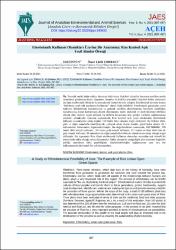| dc.contributor.author | Ekren, Erdi | |
| dc.contributor.author | Çorbacı, Ömer Lütfü | |
| dc.date.accessioned | 2023-02-14T06:22:49Z | |
| dc.date.available | 2023-02-14T06:22:49Z | |
| dc.date.issued | 2021 | en_US |
| dc.identifier.citation | Ekren, E. & Çorbacı, Ö.L. (2021). Etnobotanik Kullanım Olanakları Üzerine Bir Araştırma: Rize Kentsel Açık Yeşil Alanlar Örneği. Journal of Anatolian Environmental and Animal Sciences, 6(4), 487-497. https://doi.org/10.35229/jaes.945633 | en_US |
| dc.identifier.issn | 2548-0006 | |
| dc.identifier.uri | https://doi.org/10.35229/jaes.945633 | |
| dc.identifier.uri | https://hdl.handle.net/11436/7569 | |
| dc.description.abstract | İnsanlık tarihi kadar eskiye dayanan bitki-insan ilişkileri yüzyıllar boyunca nesilden nesile
aktarılarak günümüze kadar ulaşmıştır. İnsanlar ile bitkiler arasındaki ilişkileri bütün yönleriyle
ele alan etnobotanik bilimi de bu konuda çok önemli bir role sahiptir. Etnobotanik kavramı kısaca
“bitkilerin yerel halk tarafından kullanımı” olarak ifade edilebilir. Etnobotanik çalışmalar; yerel
halkların kültürlerinin korunmasına ve gelecek nesillere aktarılmasına, biyolojik çeşitliliğin
korunmasına, kırsal kalkınmaya destek olunmasına, nadir, endemik ve nesli tükenme tehlikesi
altında olan türlerin tespit edilerek bu türlerin korunması için gerekli verilerin sağlanmasına
yardımcı olmaktadır. Çalışma kapsamında Rize kentsel açık yeşil alanlarında etnobotanik
kullanım olanaklarına sahip toplam 160 farklı bitki taksonu tespit edilmiştir. Bu bitkiler tıbbi,
gıda ve diğer amaçlarla (mobilyacılık, yakacak odun, boyar madde, güzel koku amaçlı vb.)
kullanımları bakımından değerlendirilmiştir. Bu değerlendirme sonucunda, 160 bitkiden; 155
tanesi tıbbi amaçlı kullanım, 116 tanesi gıda amaçlı kullanım, 111 tanesi ise hem tıbbi hem de
gıda amaçlı kullanım, 96 tanesinin ise diğer amaçlarla kullanım olanaklarına sahip olduğu tespit
edilmiştir. Bu kapsamda Rize ilinin etnobotanik kullanım olanakları açısından çok önemli bir
potansiyele sahip olduğu ortaya konmuştur. Sahip olunan bu zenginliğin yöre insanına doğru bir
şekilde tanıtılması bitki çeşitliliğinin sürdürülebilirliğini sağlamasının yanı sıra ilin
kalkınmasında da önemli bir rol üstlenecektir | en_US |
| dc.description.abstract | Plant-human relations, which date back to the history of humanity, have been
transferred from generation to generation for centuries and have reached the present day.
Ethnobotany science, which deals with all aspects of the relationships between humans and
plants, plays a very important role in this regard. The concept of ethnobotany can be briefly
expressed as "the use of plants by the local people". Ethnobotanical studies; It helps to protect the
cultures of local peoples and transfer them to future generations, protect biodiversity, support
rural development, identify rare, endemic and endangered species and provide necessary data for
the protection of these species. Within the scope of the study, a total of 160 different plant taxa
with ethnobotanical usage opportunities were determined in the urban open green areas of Rize.
These plants have been evaluated in terms of their use for medicinal, food and other purposes
(furniture, firewood, dyestuff, fragrance, etc.). As a result of this evaluation, from 160 plants; It
was determined that 155 of them were for medical use, 116 were for food use, 111 were for both
medical and food use, and 96 were for other purposes. In this context, it has been revealed that
the province of Rize has a very important potential in terms of ethnobotanical use possibilities.
The accurate introduction of this wealth to the local people will play an important role in the
development of the province as well as ensuring the sustainability of plant diversity. | en_US |
| dc.language.iso | tur | en_US |
| dc.rights | info:eu-repo/semantics/openAccess | en_US |
| dc.subject | Etnobotanik | en_US |
| dc.subject | Kentsel açık yeşil alanlar | en_US |
| dc.subject | Rize | en_US |
| dc.subject | Ethnobotany | en_US |
| dc.subject | Urban open green areas | en_US |
| dc.title | Etnobotanik kullanım olanakları üzerine bir araştırma: Rize kentsel açık yeşil alanlar örneği | en_US |
| dc.title.alternative | A study on ethnobotanical possibility of uses: The example of Rize urban open green spaces | en_US |
| dc.type | article | en_US |
| dc.contributor.department | RTEÜ, Mühendislik ve Mimarlık Fakültesi, Peyzaj Mimarlığı Bölümü | en_US |
| dc.contributor.institutionauthor | Çorbacı, Ömer Lütfü | |
| dc.identifier.doi | 10.35229/jaes.945633 | en_US |
| dc.identifier.volume | 6 | en_US |
| dc.identifier.issue | 4 | en_US |
| dc.identifier.startpage | 487 | en_US |
| dc.identifier.endpage | 497 | en_US |
| dc.relation.journal | Journal of Anatolian Environmental and Animal Sciences | en_US |
| dc.relation.publicationcategory | Makale - Uluslararası Hakemli Dergi - Kurum Öğretim Elemanı | en_US |


















